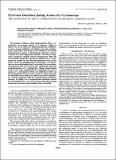Por favor, use este identificador para citar o enlazar a este item:
http://hdl.handle.net/10261/177867COMPARTIR / EXPORTAR:
 SHARE
BASE SHARE
BASE
|
|
| Visualizar otros formatos: MARC | Dublin Core | RDF | ORE | MODS | METS | DIDL | DATACITE | |

| Campo DC | Valor | Lengua/Idioma |
|---|---|---|
| dc.contributor.author | Pérez-Sala, Dolores | es_ES |
| dc.contributor.author | Cerdán, Sebastián | es_ES |
| dc.contributor.author | Ballesteros, Paloma | es_ES |
| dc.contributor.author | Sánchez Ayuso, Matilde | es_ES |
| dc.contributor.author | Parrilla, Roberto L. | es_ES |
| dc.date.accessioned | 2019-03-13T12:45:44Z | - |
| dc.date.available | 2019-03-13T12:45:44Z | - |
| dc.date.issued | 1986-10-25 | - |
| dc.identifier.citation | The Journal of Biological Chemistry 261:13969-13972 (1986) | es_ES |
| dc.identifier.issn | 0021-9258 | - |
| dc.identifier.uri | http://hdl.handle.net/10261/177867 | - |
| dc.description | 4 p.-7 fig. | es_ES |
| dc.description.abstract | We present evidence which demonstrates that L-cycloserine, structural analog of L-alanine, which is known to be an effective aminotransferase inhibitor, is also a potent inhibitor of cellular pyruvate metabolism. This effect was found to be related to its almost instantaneous action in decreasing pyruvate concentrations in a dose-dependent manner. 1H nuclear magnetic resonance studies clearly demonstrate that the irreversible removal of pyruvate induced by L-cycloserine is caused by the decarboxylating action of the latter. Pyruvate disappearance induced by L-cycloserine can be stoichiometrically accounted for as acetate. The process does not involve any chemically detected transformation of L-cycloserine. These observations lead to two main considerations regarding the known action of L-cycloserine. First, its inhibitory effect on gluconeogenesis from lactate could be explained only on the basis of its ability to reduce pyruvate availability with no apparent need for transaminase inhibition. Second, its ability as a transaminase inhibitor should be reconsidered in view of its potent decarboxylating action on pyruvate and probably other oxoacids. | es_ES |
| dc.description.sponsorship | This work has been supported in part by Grants 174 and 1674 from the Spanish Comisión Asesora de Investigación Cientifica y Técnica, and Fondo de Investigaciones Sanitarias Grants 85/839 and 85/1321. | es_ES |
| dc.language.iso | eng | es_ES |
| dc.publisher | American Society for Biochemistry and Molecular Biology | es_ES |
| dc.relation.isversionof | Publisher's version | es_ES |
| dc.rights | openAccess | es_ES |
| dc.title | Pyruvate decarboxylating action of L-cycloserine. The significance of this in understanding its metabolic inhibitory action | es_ES |
| dc.type | artículo | es_ES |
| dc.description.peerreviewed | Peer reviewed | es_ES |
| dc.relation.publisherversion | http://www.jbc.org/content/261/30/13969.long | es_ES |
| dc.identifier.e-issn | 1083-351X | - |
| dc.contributor.funder | Comisión Asesora de Investigación Científica y Técnica, CAICYT (España) | es_ES |
| dc.contributor.funder | Instituto de Salud Carlos III | es_ES |
| dc.relation.csic | Sí | es_ES |
| oprm.item.hasRevision | no ko 0 false | * |
| dc.identifier.funder | http://dx.doi.org/10.13039/501100007272 | es_ES |
| dc.identifier.funder | http://dx.doi.org/10.13039/501100004587 | es_ES |
| dc.contributor.orcid | Pérez-Sala, Dolores [0000-0003-0600-665X] | es_ES |
| dc.contributor.orcid | Cerdán, Sebastián [0000-0001-9965-0270] | es_ES |
| dc.contributor.orcid | Ballesteros, Paloma [0000-0001-7763-8975] | es_ES |
| dc.contributor.orcid | Sánchez Ayuso, Matilde [0000-0003-2504-0925] | es_ES |
| dc.type.coar | http://purl.org/coar/resource_type/c_6501 | es_ES |
| item.cerifentitytype | Publications | - |
| item.openairecristype | http://purl.org/coar/resource_type/c_18cf | - |
| item.grantfulltext | open | - |
| item.openairetype | artículo | - |
| item.fulltext | With Fulltext | - |
| item.languageiso639-1 | en | - |
| Aparece en las colecciones: | (CIB) Artículos | |
Ficheros en este ítem:
| Fichero | Descripción | Tamaño | Formato | |
|---|---|---|---|---|
| J. Biol. Chem.-1986-Pérez-Sala-13969-72.pdf | Artículo principal | 454,03 kB | Adobe PDF |  Visualizar/Abrir |
CORE Recommender
Page view(s)
144
checked on 02-may-2024
Download(s)
199
checked on 02-may-2024
Google ScholarTM
Check
NOTA: Los ítems de Digital.CSIC están protegidos por copyright, con todos los derechos reservados, a menos que se indique lo contrario.
